Secure CAPTCHA by Genetic Algorithm (GA) and Multi-Layer Perceptron (MLP)
Abstract
:1. Introduction
2. Background and Related Works
3. Abbreviations and Notations
4. The Proposed Method
- Choose a random chromosome value between 0 and 1;
- Go to the next step and mutate if the number is bigger than the mutation threshold (a value between 0 and 1), otherwise skip mutation;
- Choose a random number that indicates one of the chromosome genes and makes a numerical mutation.
5. Implementation and Experiments
- Defining the initial parameters such as population, number of iterations, mutation rate, and crossover rate of GA;
- Preprocessing and normalizing part of input data to reduce learning errors and enhance performance in hand movement detection;
- Dividing the dataset into training and evaluation parts;
- Producing chromosomes for MLP and applying mutation and crossover on the chromosomes to find the optimum weight and bias and reduce the error rate;
- Evaluating the method according to the metrics in Section 5.2.
5.1. Dataset
5.2. Evaluation Metrics
5.3. Error Analysis by Increasing Population and Iterations
- Increasing the number of chromosomes increases the number of neural networks for prediction and results in a more accurate classification;
- Increasing population produces more and more diverse test ratios in GA, and accordingly increases the chance of finding a final and accurate answer;
- Increasing chromosomes in GA increases problem search space that normally results in reaching optimum answers and reducing error;
- Increasing the population increases the number of elite members and enhances the probability of mutation and crossover. This leads to increasing the chance of having a more accurate MLP for hand pose prediction.
6. Evaluation
7. Conclusions
Author Contributions
Funding
Data Availability Statement
Conflicts of Interest
References
- Moradi, M.; Keyvanpour, M. CAPTCHA and its Alternatives: A Review. Secur. Commun. Netw. 2015, 8, 2135–2156. [Google Scholar] [CrossRef]
- Chaeikar, S.S.; Alizadeh, M.; Tadayon, M.H.; Jolfaei, A. An intelligent cryptographic key management model for secure communications in distributed industrial intelligent systems. Int. J. Intell. Syst. 2021, 37, 10158–10171. [Google Scholar] [CrossRef]
- Von Ahn, L.; Blum, M.; Langford, J. Telling humans and computers apart automatically. Commun. ACM 2004, 47, 56–60. [Google Scholar] [CrossRef]
- Chellapilla, K.; Larson, K.; Simard, P.; Czerwinski, M. Designing human friendly human interaction proofs (HIPs). In Proceedings of the SIGCHI Conference on Human Factors in Computing Systems, Portland, OR, USA, 2–7 April 2005; pp. 711–720. [Google Scholar]
- Chaeikar, S.S.; Jolfaei, A.; Mohammad, N.; Ostovari, P. Security principles and challenges in electronic voting. In Proceedings of the 2021 IEEE 25th International Enterprise Distributed Object Computing Workshop (EDOCW), Gold Coast, Australia, 25–29 October 2021; pp. 38–45. [Google Scholar]
- Arteaga, M.V.; Castiblanco, J.C.; Mondragon, I.F.; Colorado, J.D.; Alvarado-Rojas, C. EMG-driven hand model based on the classification of individual finger movements. Biomed. Signal Process. Control. 2020, 58, 101834. [Google Scholar] [CrossRef]
- Lupinetti, K.; Ranieri, A.; Giannini, F.; Monti, M. 3d dynamic hand gestures recognition using the leap motion sensor and convolutional neural networks. In Proceedings of the International Conference on Augmented Reality, Virtual Reality and Computer Graphics, Lecce, Italy, 7–9 September 2020; pp. 420–439. [Google Scholar]
- Cobos-Guzman, S.; Verdú, E.; Herrera-Viedma, E.; Crespo, R.G. Fuzzy logic expert system for selecting robotic hands using kinematic parameters. J. Ambient. Intell. Humaniz. Comput. 2020, 11, 1553–1564. [Google Scholar] [CrossRef]
- Martinelli, D.; Sousa, A.L.; Augusto, M.E.; Kalempa, V.C.; de Oliveira, A.S.; Rohrich, R.F.; Teixeira, M.A. Remote control for mobile robots using gestures captured by the rgb camera and recognized by deep learning techniques. In Proceedings of the 2019 Latin American Robotics Symposium (LARS), 2019 Brazilian Symposium on Robotics (SBR) and 2019 Workshop on Robotics in Education (WRE), Rio Grande, Brazil, 22–26 October 2019; pp. 98–103. [Google Scholar]
- Chaeikar, S.S.; Ahmadi, A.; Karamizadeh, S.; Chaeikar, N.S. SIKM–a smart cryptographic key management framework. Open Comput. Sci. 2022, 12, 17–26. [Google Scholar] [CrossRef]
- Khodadadi, T.; Javadianasl, Y.; Rabiei, F.; Alizadeh, M.; Zamani, M.; Chaeikar, S.S. A novel graphical password authentication scheme with improved usability. In Proceedings of the 2021 4th International Symposium on Advanced Electrical and Communication Technologies (ISAECT), Alkhobar, Saudi Arabia, 6–8 December 2021; pp. 01–04. [Google Scholar]
- Chew, M.; Baird, H.S. Baffletext: A human interactive proof. In Document Recognition and Retrieval X; SPIE: Bellingham, WA, USA, 2003; Volume 5010, pp. 305–316. [Google Scholar]
- Baird, H.S.; Coates, A.L.; Fateman, R.J. Pessimalprint: A reverse turing test. Int. J. Doc. Anal. Recognit. 2003, 5, 158–163. [Google Scholar] [CrossRef]
- Mori, G.; Malik, J. Recognizing objects in adversarial clutter: Breaking a visual CAPTCHA. In Proceedings of the 2003 IEEE Computer Society Conference on Computer Vision and Pattern Recognition, Madison, WI, USA, 18–20 June 2003; Volume 1, p. I. [Google Scholar]
- Baird, H.S.; Moll, M.A.; Wang, S.Y. ScatterType: A legible but hard-to-segment CAPTCHA. In Proceedings of the Eighth International Conference on Document Analysis and Recognition (ICDAR’05), Seoul, Republic of Korea, 31 August–1 September 2005; pp. 935–939. [Google Scholar]
- Wang, D.; Moh, M.; Moh, T.S. Using Deep Learning to Solve Google reCAPTCHA v2’s Image Challenges. In Proceedings of the 2020 14th International Conference on Ubiquitous Information Management and Communication (IMCOM), Seoul, Republic of Korea, 3–5 January 2020; pp. 1–5. [Google Scholar]
- Singh, V.P.; Pal, P. Survey of different types of CAPTCHA. Int. J. Comput. Sci. Inf. Technol. 2014, 5, 2242–2245. [Google Scholar]
- Bursztein, E.; Aigrain, J.; Moscicki, A.; Mitchell, J.C. The End is Nigh: Generic Solving of Text-based {CAPTCHAs}. In Proceedings of the 8th USENIX Workshop on Offensive Technologies (WOOT 14), San Diego, CA, USA, 19 August 2014. [Google Scholar]
- Obimbo, C.; Halligan, A.; De Freitas, P. CaptchAll: An improvement on the modern text-based CAPTCHA. Procedia Comput. Sci. 2013, 20, 496–501. [Google Scholar] [CrossRef]
- Datta, R.; Li, J.; Wang, J.Z. Imagination: A robust image-based captcha generation system. In Proceedings of the 13th annual ACM international conference on Multimedia, Brisbane, Australia, 26–30 October 2005; pp. 331–334. [Google Scholar]
- Rui, Y.; Liu, Z. Artifacial: Automated reverse turing test using facial features. In Proceedings of the eleventh ACM International Conference on Multimedia, Berkeley, CA, USA, 2–8 November 2003; pp. 295–298. [Google Scholar]
- Elson, J.; Douceur, J.R.; Howell, J.; Saul, J. Asirra: A CAPTCHA that exploits interest-aligned manual image categorization. CCS 2007, 7, 366–374. [Google Scholar]
- Hoque, M.E.; Russomanno, D.J.; Yeasin, M. 2d captchas from 3d models. In Proceedings of the IEEE SoutheastCon, Memphis, TN, USA, 31 March 2006; pp. 165–170. [Google Scholar]
- Gao, H.; Yao, D.; Liu, H.; Liu, X.; Wang, L. A novel image based CAPTCHA using jigsaw puzzle. In Proceedings of the 2010 13th IEEE International Conference on Computational Science and Engineering, Hong Kong, China, 11–13 December 2010; pp. 351–356. [Google Scholar]
- Gao, S.; Mohamed, M.; Saxena, N.; Zhang, C. Emerging image game CAPTCHAs for resisting automated and human-solver relay attacks. In Proceedings of the 31st Annual Computer Security Applications Conference, Los Angeles, CA, USA, 7–11 December 2015; pp. 11–20. [Google Scholar]
- Cui, J.S.; Mei, J.T.; Wang, X.; Zhang, D.; Zhang, W.Z. A captcha implementation based on 3d animation. In Proceedings of the 2009 International Conference on Multimedia Information Networking and Security, Hubei, China, 18–20 November 2019; Volume 2, pp. 179–182. [Google Scholar]
- Winter-Hjelm, C.; Kleming, M.; Bakken, R. An interactive 3D CAPTCHA with semantic information. In Proceedings of the Norwegian Artificial Intelligence Symp, Trondheim, Norway, 26–28 November 2009; pp. 157–160. [Google Scholar]
- Shirali-Shahreza, S.; Ganjali, Y.; Balakrishnan, R. Verifying human users in speech-based interactions. In Proceedings of the Twelfth Annual Conference of the International Speech Communication Association, Florence, Italy, 27–31 August 2011. [Google Scholar]
- Chan, N. Sound oriented CAPTCHA. In Proceedings of the First Workshop on Human Interactive Proofs (HIP), Bethlehem, PA, USA, 19–20 May 2022; Available online: http://www.aladdin.cs.cmu.edu/hips/events/abs/nancy_abstract.pdf (accessed on 25 July 2023).
- Holman, J.; Lazar, J.; Feng, J.H.; D’Arcy, J. Developing usable CAPTCHAs for blind users. In Proceedings of the 9th international ACM SIGACCESS conference on Computers and Accessibility, Tempe, AZ, USA, 15–17 October 2007 (pp. 245-246). [Google Scholar]
- Schlaikjer, A. A dual-use speech CAPTCHA: Aiding visually impaired web users while providing transcriptions of Audio Streams. LTI-CMU Tech. Rep. 2007, 7–14. Available online: http://lti.cs.cmu.edu/sites/default/files/CMU-LTI-07-014-T.pdf (accessed on 25 July 2023).
- Lupkowski, P.; Urbanski, M. SemCAPTCHA—User-friendly alternative for OCR-based CAPTCHA systems. In Proceedings of the 2008 international multiconference on computer science and information technology, Wisla, Poland, 20–22 October 2018; pp. 325–329. [Google Scholar]
- Yamamoto, T.; Tygar, J.D.; Nishigaki, M. 2010, Captcha using strangeness in machine translation. In Proceedings of the 2010 24th IEEE International Conference on Advanced Information Networking and Applications, Perth, Australia, 20–23 April 2010; pp. 430–437. [Google Scholar]
- Gaggi, O. A study on Accessibility of Google ReCAPTCHA Systems. In Proceedings of the Open Challenges in Online Social Networks, Virtual Event, 30 August–2 September 2022; pp. 25–30. [Google Scholar]
- Yadava, P.; Sahu, C.; Shukla, S. Time-variant Captcha: Generating strong Captcha Security by reducing time to automated computer programs. J. Emerg. Trends Comput. Inf. Sci. 2011, 2, 701–704. [Google Scholar]
- Wang, L.; Chang, X.; Ren, Z.; Gao, H.; Liu, X.; Aickelin, U. Against spyware using CAPTCHA in graphical password scheme. In Proceedings of the 2010 24th IEEE International Conference on Advanced Information Networking and Applications, Perth, Australia, 20–23 April 2010; pp. 760–767. [Google Scholar]
- Belk, M.; Fidas, C.; Germanakos, P.; Samaras, G. Do cognitive styles of users affect preference and performance related to CAPTCHA challenges? In Proceedings of the CHI’12 Extended Abstracts on Human Factors in Computing Systems, Stratford, ON, Canada, 5–10 May 2012; pp. 1487–1492. [Google Scholar]
- Wei, T.E.; Jeng, A.B.; Lee, H.M. GeoCAPTCHA—A novel personalized CAPTCHA using geographic concept to defend against 3 rd Party Human Attack. In Proceedings of the 2012 IEEE 31st International Performance Computing and Communications Conference (IPCCC), Austin, TX, USA, 1–3 December 2012; pp. 392–399. [Google Scholar]
- Jiang, N.; Dogan, H. A gesture-based captcha design supporting mobile devices. In Proceedings of the 2015 British HCI Conference, Lincoln, UK, 13–17 July 2015; pp. 202–207. [Google Scholar]
- Pritom, A.I.; Chowdhury, M.Z.; Protim, J.; Roy, S.; Rahman, M.R.; Promi, S.M. Combining movement model with finger-stroke level model towards designing a security enhancing mobile friendly captcha. In Proceedings of the 2020 9th International Conference on Software and Computer Applications, Langkawi, Malaysia, 2020, 18–21 February; pp. 351–356.
- Parvez, M.T.; Alsuhibany, S.A. Segmentation-validation based handwritten Arabic CAPTCHA generation. Comput. Secur. 2020, 95, 101829. [Google Scholar] [CrossRef]
- Shah, A.R.; Banday, M.T.; Sheikh, S.A. Design of a drag and touch multilingual universal captcha challenge. In Advances in Computational Intelligence and Communication Technology; Springer: Singapore, 2021; pp. 381–393. [Google Scholar]
- Luzhnica, G.; Simon, J.; Lex, E.; Pammer, V. A sliding window approach to natural hand gesture recognition using a custom data glove. In Proceedings of the 2016 IEEE Symposium on 3D User Interfaces (3DUI), Greenville, SC, USA, 19–20 March 2016; pp. 81–90. [Google Scholar]
- Hung, C.H.; Bai, Y.W.; Wu, H.Y. Home outlet and LED array lamp controlled by a smartphone with a hand gesture recognition. In Proceedings of the 2016 IEEE International Conference on Consumer Electronics (ICCE), Las Vegas, NV, USA, 7–11 January 2016; pp. 5–6. [Google Scholar]
- Chen, Y.; Ding, Z.; Chen, Y.L.; Wu, X. Rapid recognition of dynamic hand gestures using leap motion. In Proceedings of the 2015 IEEE International Conference on Information and Automation, Lijiang, China, 8–11 August 2015; pp. 1419–1424. [Google Scholar]
- Panwar, M.; Mehra, P.S. Hand gesture recognition for human computer interaction. In Proceedings of the 2011 International Conference on Image Information Processing, Brussels, Belgium, 11–14 November 2011; pp. 1–7. [Google Scholar]
- Chaudhary, A.; Raheja, J.L. Bent fingers’ angle calculation using supervised ANN to control electro-mechanical robotic hand. Comput. Electr. Eng. 2013, 39, 560–570. [Google Scholar] [CrossRef]
- Marium, A.; Rao, D.; Crasta, D.R.; Acharya, K.; D’Souza, R. Hand gesture recognition using webcam. Am. J. Intell. Syst. 2017, 7, 90–94. [Google Scholar]
- Simion, G.; David, C.; GSimion, G.; David, C.; Gui, V.; Caleanu, C.D. Fingertip-based real time tracking and gesture recognition for natural user interfaces. Acta Polytech. Hung. 2016, 13, 189–204. [Google Scholar]
- Chaudhary, A.; Raheja, J.L.; Raheja, S. A vision based geometrical method to find fingers positions in real time hand gesture recognition. J. Softw. 2012, 7, 861–869. [Google Scholar] [CrossRef]
- Benitez-Garcia, G.; Olivares-Mercado, J.; Sanchez-Perez, G.; Yanai, K. IPN hand: A video dataset and benchmark for real-time continuous hand gesture recognition. In Proceedings of the 2020 25th International Conference on Pattern Recognition (ICPR), Milan, Italy, 10–15 January 2021; pp. 4340–4347. [Google Scholar]
- Li, Y.M.; Lee, T.H.; Kim, J.S.; Lee, H.J. Cnn-based real-time hand and fingertip recognition for the design of a virtual keyboard. In Proceedings of the 2021 36th International Technical Conference on Circuits/Systems, Computers and Communications (ITC-CSCC), Jeju, Republic of Korea, 27–30 June 2021; pp. 1–3. [Google Scholar]
- Redmon, J.; Farhadi, A. 2018. Yolov3: An incremental improvement. arxiv preprint 2018, arXiv:1804.02767. [Google Scholar]
- Shull, P.B.; Jiang, S.; Zhu, Y.; Zhu, X. Hand gesture recognition and finger angle estimation via wrist-worn modified barometric pressure sensing. IEEE Trans. Neural Syst. Rehabil. Eng. 2019, 27, 724–732. [Google Scholar] [CrossRef] [PubMed]
- Manoj, H.M.; Pradeep, B.P.; Anil, C.; Rohith, S. An Novel Hand Gesture System for ASL using Kinet Sensor based Images. In Proceedings of the First International Conference on Computing, Communication and Control System, I3CAC 2021, Chennai, India, 7–8 June 2021; Bharath University: Chennai, India. [Google Scholar]

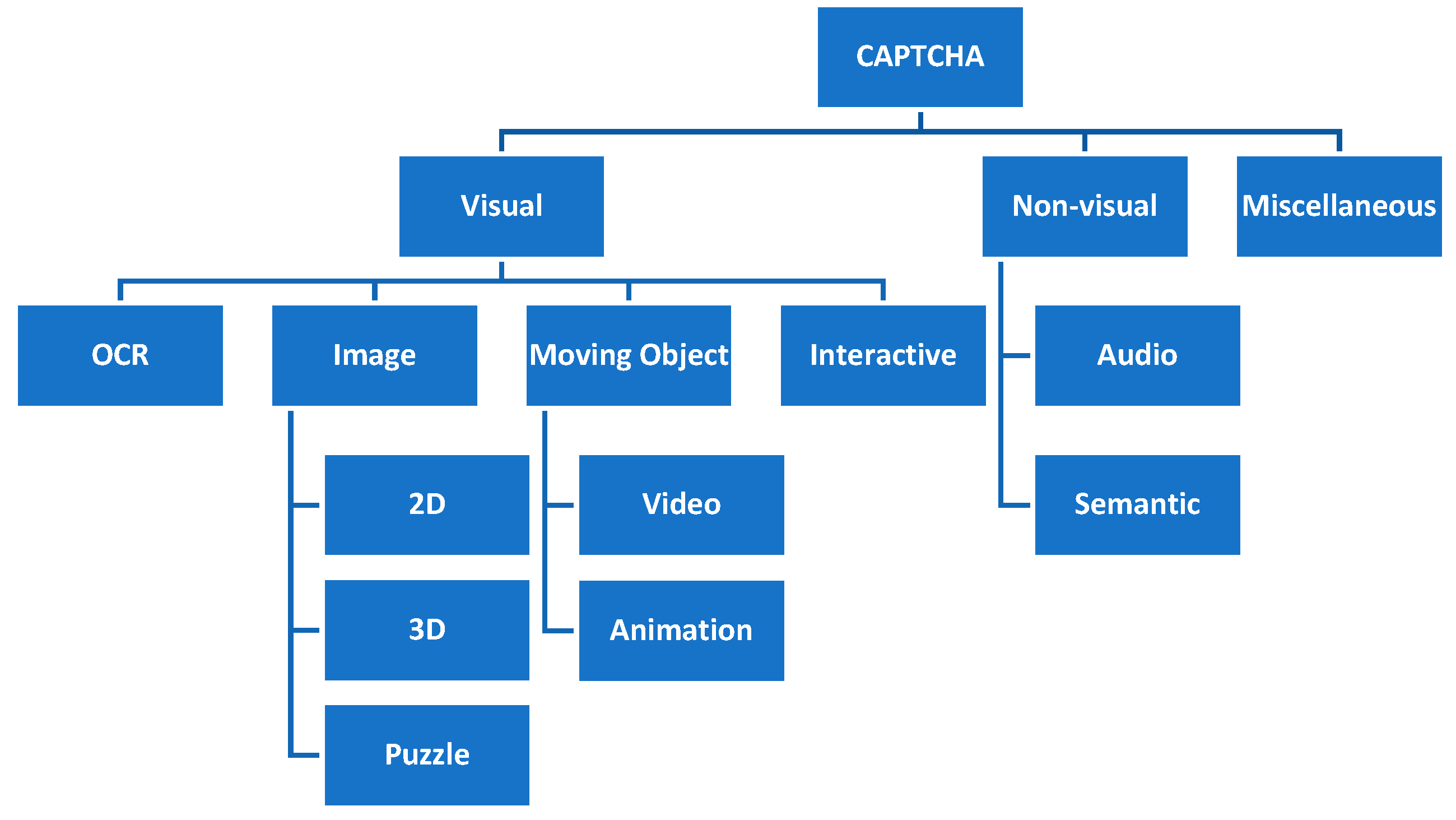

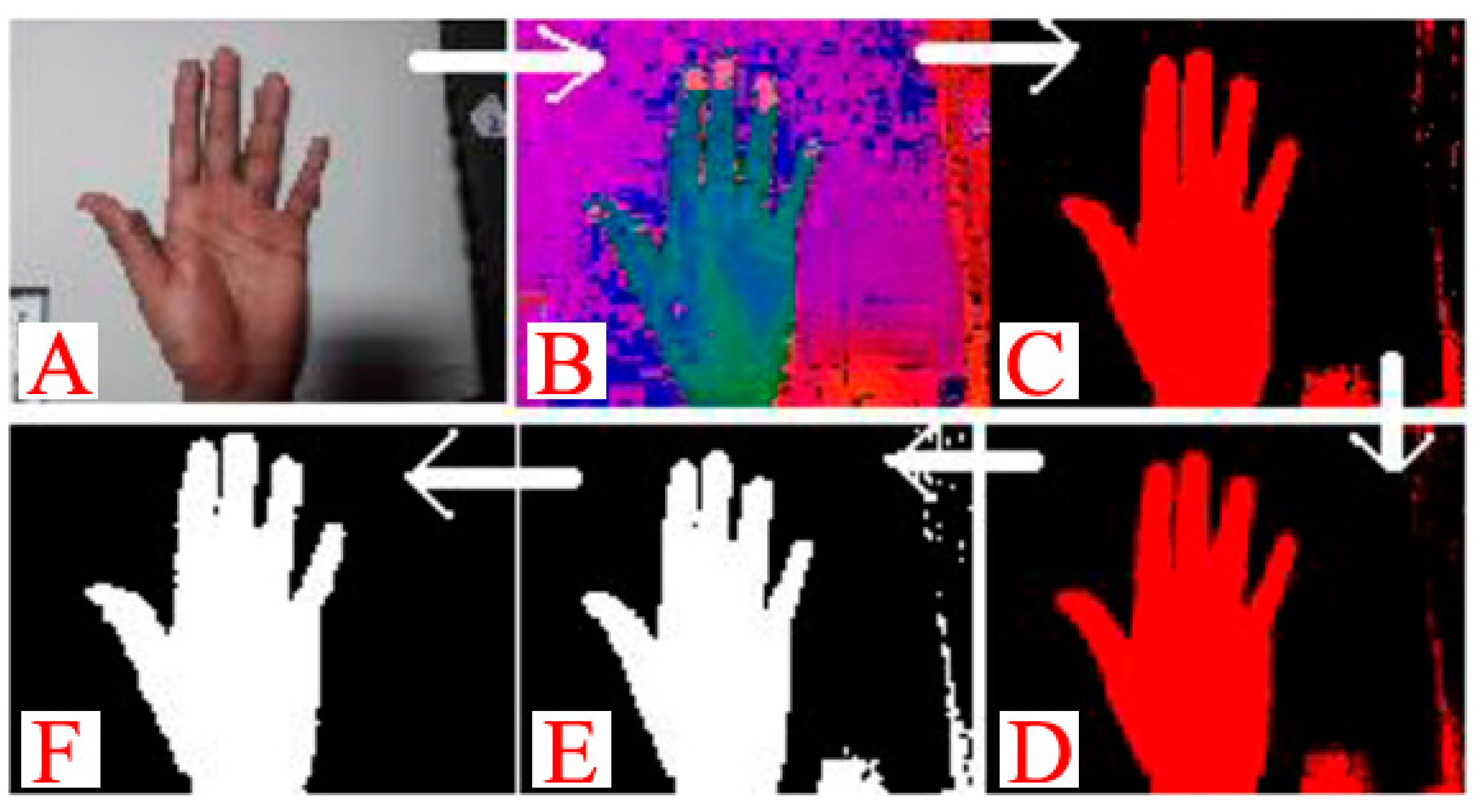
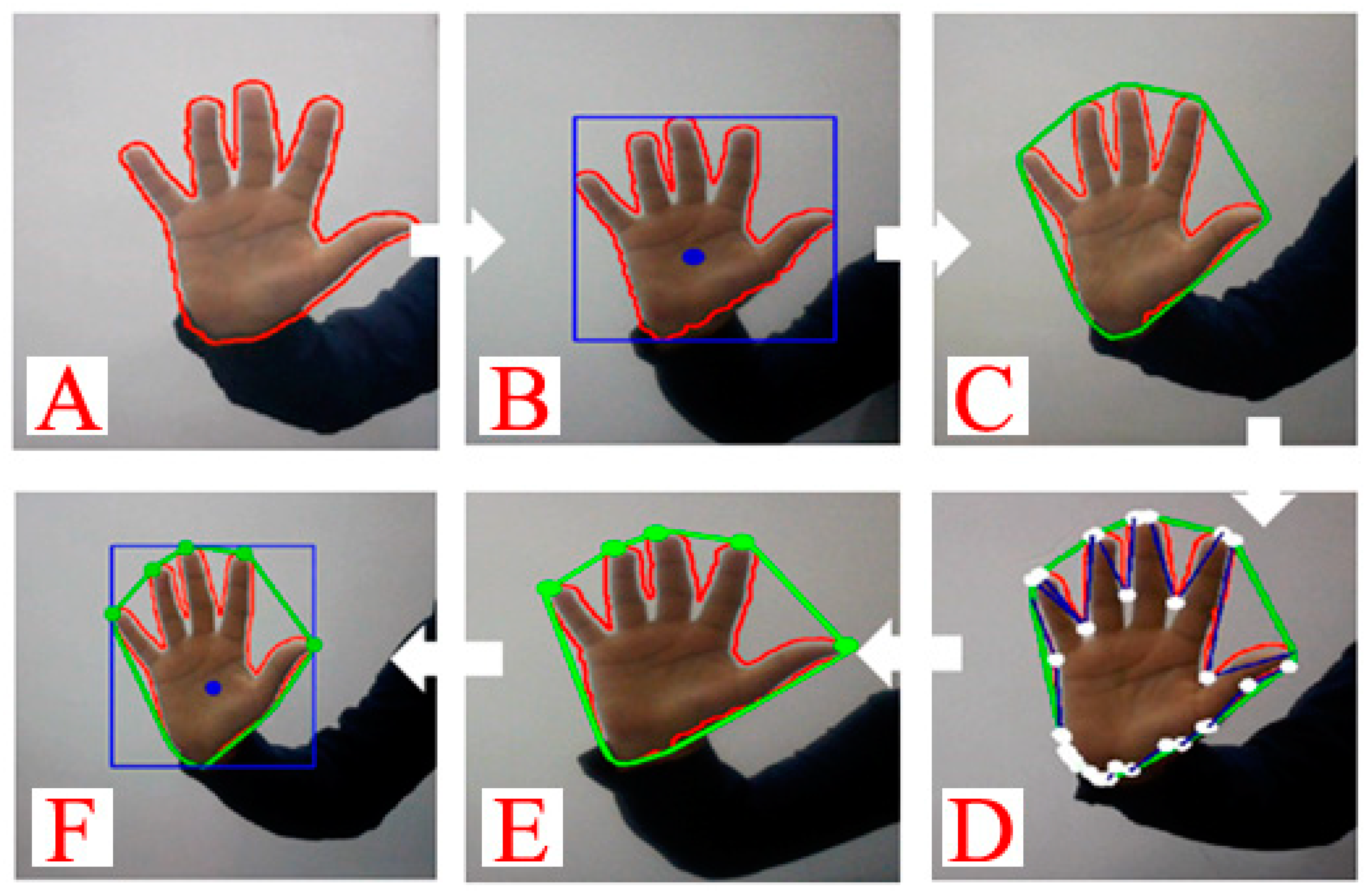

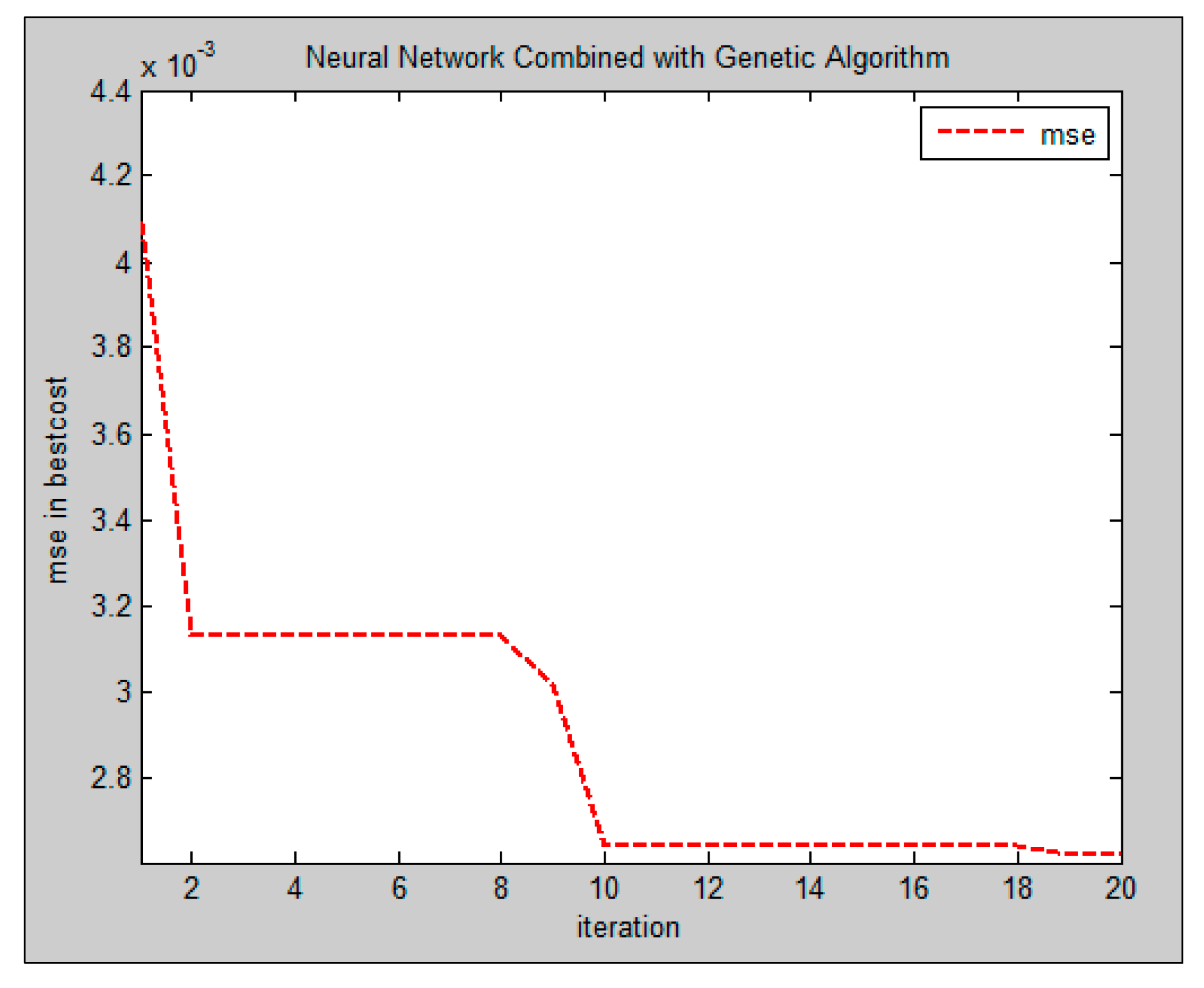

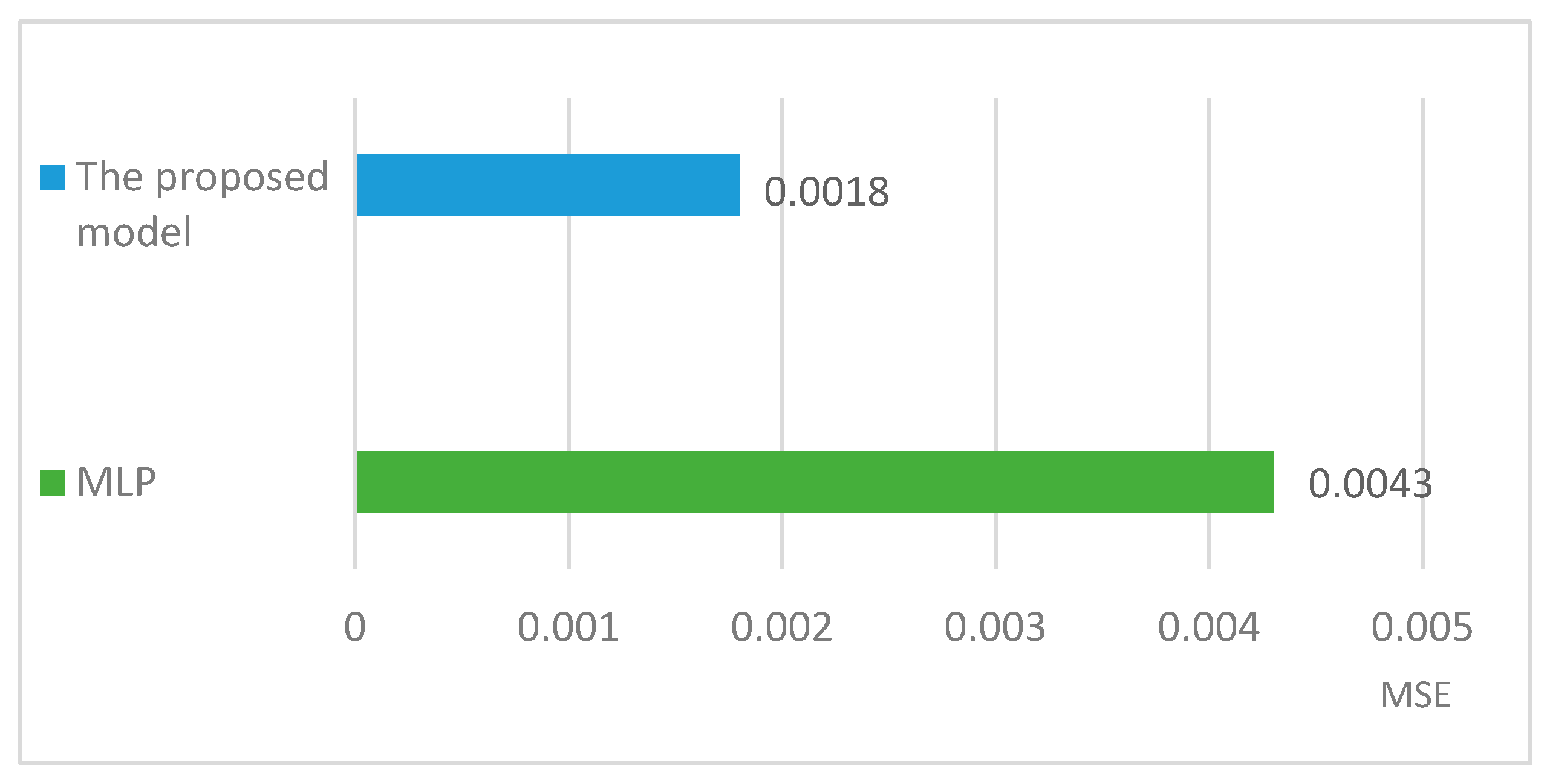

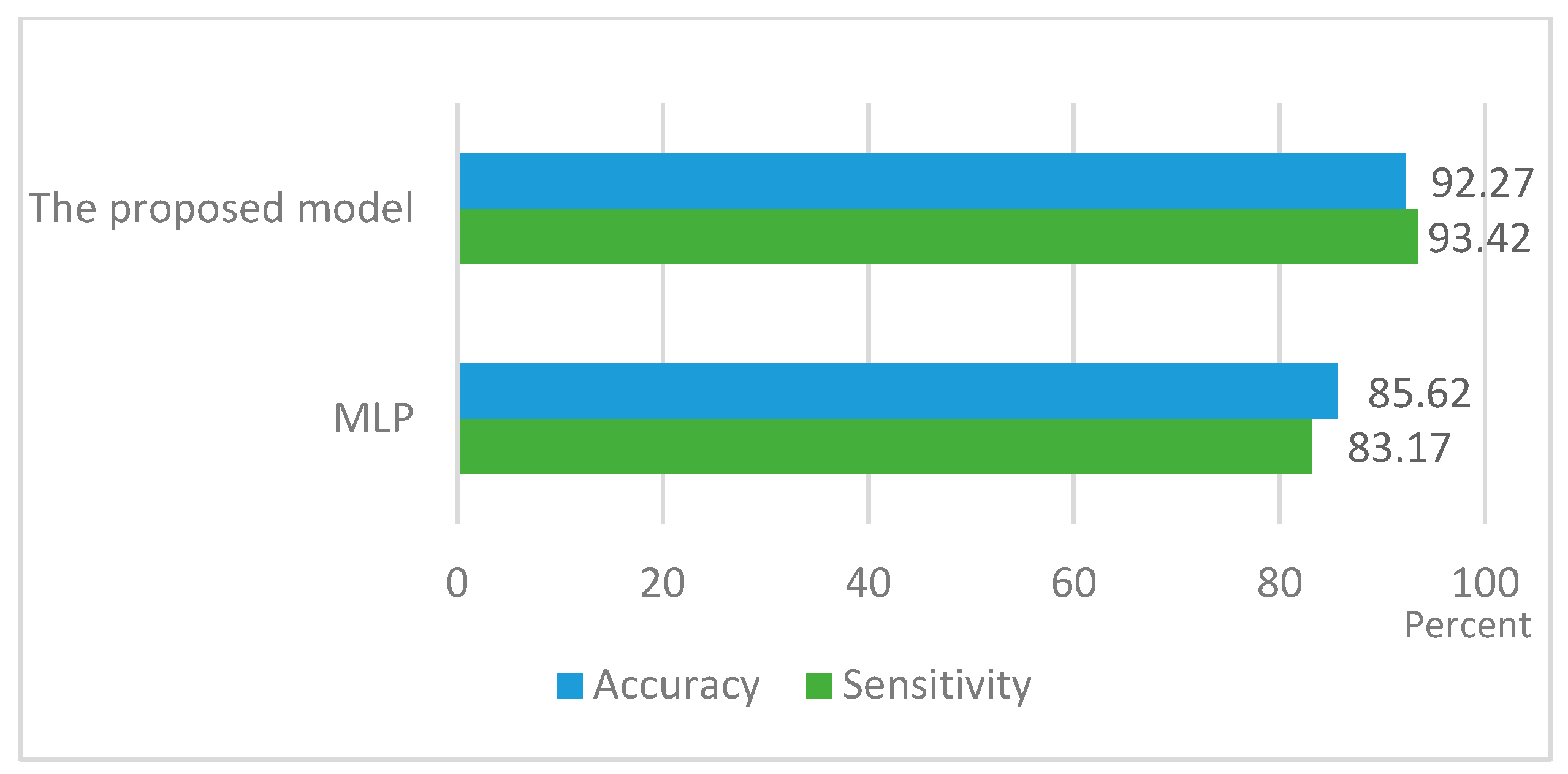
| Abbreviation/Notation | Description |
|---|---|
| CAPTCHA | Completely Automatic Public Turing test to tell Computer and Human Apart |
| ANN | Artificial Neural Networks |
| Arccosine | |
| Arctangent | |
| DL | Deep Learning |
| DoS | Denial of Service |
| Fitness function | |
| FN | False negative |
| FP | False positive |
| GA | Genetic Algorithm |
| HGR | Hand Gesture Recognition |
| HIP | Human Interaction Proofs |
| HSV | Hue-Saturation-Value |
| MLP | Multi-Layer Perceptron |
| MSE | Mean Squared Error |
| n | Number of the samples |
| OCR | Optic Character Recognition |
| Probability of selecting a chromosome in the roulette wheel | |
| Point in a vector | |
| RGB | Red, Green, Blue |
| RMSE | Root Mean Squared Error |
| ROI | Region of Interest |
| SVM | Support Vector Machines |
| TN | True negative |
| TP | True positive |
| Weight of the ith entry into the jth neuron of the hidden layer | |
| Angle |
Disclaimer/Publisher’s Note: The statements, opinions and data contained in all publications are solely those of the individual author(s) and contributor(s) and not of MDPI and/or the editor(s). MDPI and/or the editor(s) disclaim responsibility for any injury to people or property resulting from any ideas, methods, instructions or products referred to in the content. |
© 2023 by the authors. Licensee MDPI, Basel, Switzerland. This article is an open access article distributed under the terms and conditions of the Creative Commons Attribution (CC BY) license (https://creativecommons.org/licenses/by/4.0/).
Share and Cite
Shojae Chaeikar, S.; Mirzaei Asl, F.; Yazdanpanah, S.; Zamani, M.; Manaf, A.A.; Khodadadi, T. Secure CAPTCHA by Genetic Algorithm (GA) and Multi-Layer Perceptron (MLP). Electronics 2023, 12, 4084. https://doi.org/10.3390/electronics12194084
Shojae Chaeikar S, Mirzaei Asl F, Yazdanpanah S, Zamani M, Manaf AA, Khodadadi T. Secure CAPTCHA by Genetic Algorithm (GA) and Multi-Layer Perceptron (MLP). Electronics. 2023; 12(19):4084. https://doi.org/10.3390/electronics12194084
Chicago/Turabian StyleShojae Chaeikar, Saman, Fatemeh Mirzaei Asl, Saeid Yazdanpanah, Mazdak Zamani, Azizah Abdul Manaf, and Touraj Khodadadi. 2023. "Secure CAPTCHA by Genetic Algorithm (GA) and Multi-Layer Perceptron (MLP)" Electronics 12, no. 19: 4084. https://doi.org/10.3390/electronics12194084
APA StyleShojae Chaeikar, S., Mirzaei Asl, F., Yazdanpanah, S., Zamani, M., Manaf, A. A., & Khodadadi, T. (2023). Secure CAPTCHA by Genetic Algorithm (GA) and Multi-Layer Perceptron (MLP). Electronics, 12(19), 4084. https://doi.org/10.3390/electronics12194084








